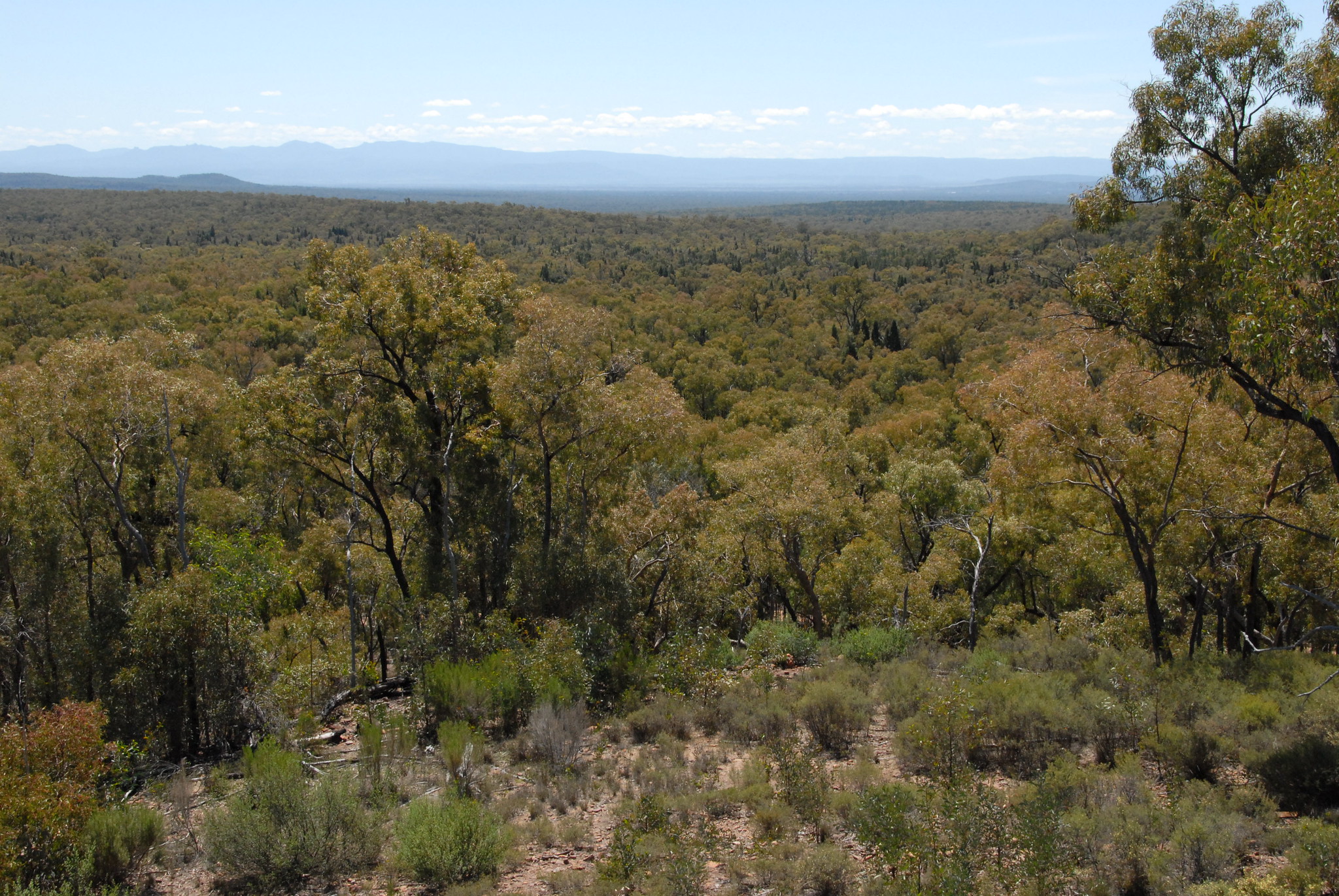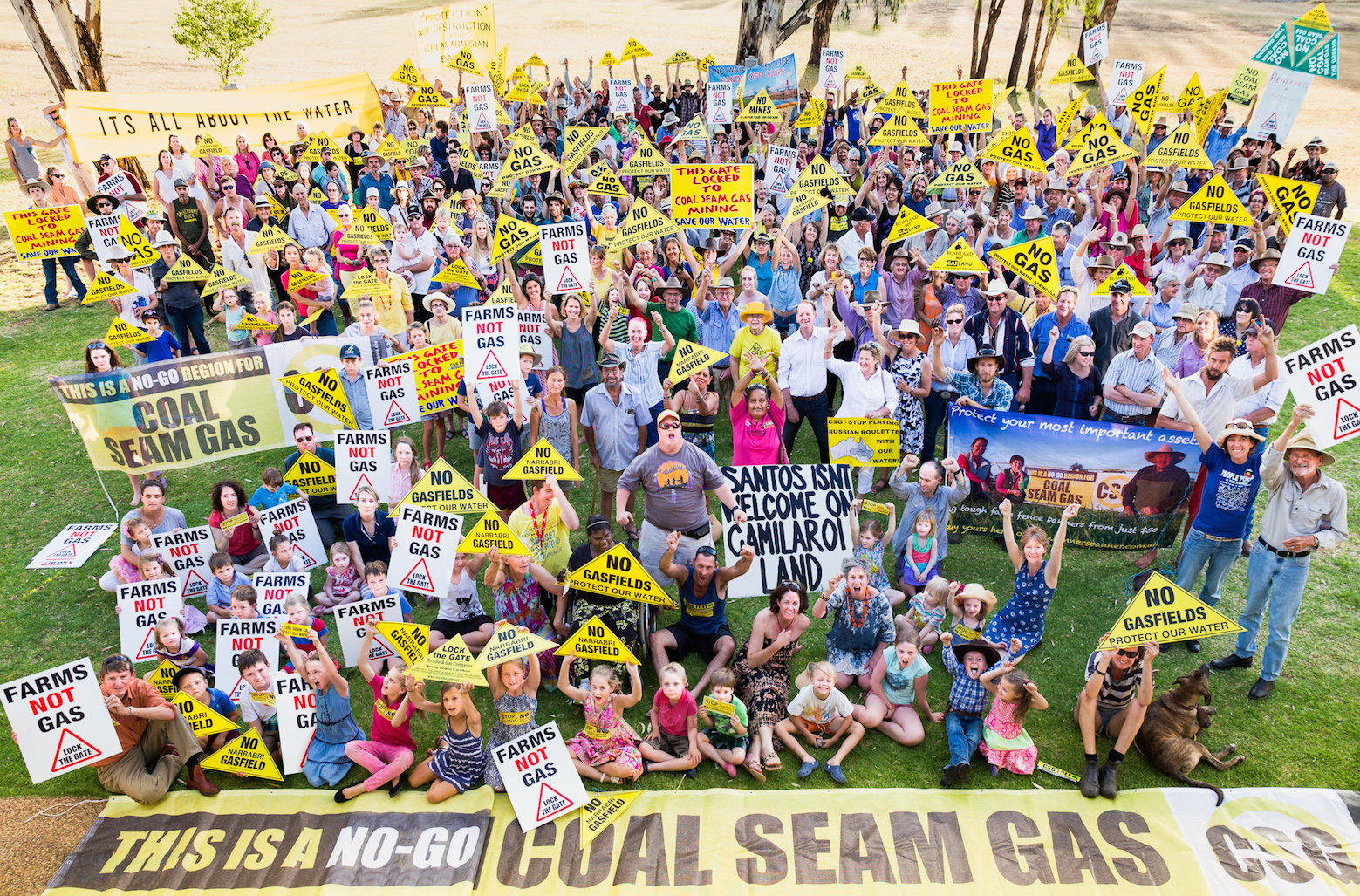In times of drought and wildfires, the Australian company Santos is pushing a project that puts eastern Australia’s vital water resources at risk.[1] Santos wants to produce fossil gas from coalbeds deep within the earth.[2] Its Narrabri project is a threat to the water and all those who depend on it: the Indigenous Gomeroi people, local farmers, residents, and the Pilliga Forest.[3]
In the Narrabri project, Santos wants to produce coalbed methane (CBM), an unconventional form of fossil gas.15257 CBM is stored in underground coalbeds at depths of hundreds of meters.[4] Pressurized water inside the coal seams holds the methane in place.[5] To extract the gas from the depths of the earth, Santos must pump the water out of the coalbed to reduce the pressure.[6][7] This allows the gas to flow to the surface.[8]
In the Narrabri project area, Santos is preparing to drill 850 gas wells spread over 95,000 hectares (950 km2).[9] Santos has invested AUD 1.5 billion in the project over the last decade, which has faced continuous delays.12417 In November 2020, the federal Australian government gave Santos the initial green light for its Narrabri project.[10] The company has still not made a final investment decision on proceeding with development.[11] However, governmental authorities have repeatedly expressed support for Santos’ Narrabri CBM project and its potential future expansion to more than 10,000 wells spread across 1,000,000 hectares.[12][13]
When Santos fiddles with water, it plays with fire. The coalbeds that Santos wants to drill into lie underneath the Great Artesian Basin (GAB).[14] The GAB is Australia’s largest groundwater reserve.[15] The basin and its connected water reservoirs are a life support system for hundreds of thousands of people in Australia.[16] If Santos removes gas and water from deep layers, overlying groundwater may sink deeper into the ground.[17] It could retreat to depths that people’s wells can no longer reach.[18] Without access to the abundant and clean water of the GAB, people in eastern and central Australia would not be able to farm or sustain their livestock, and invaluable ecosystems would perish.[19]
At the same time, Santos puts the clean and abundant water of the GAB at risk of pollution. If the Narrabri project goes ahead, the company could pump up to 37.5 billion liters (9.9 billion gallons) of water out of the coal seams.[20] This water is extremely salty and contains heavy metals and radioactive elements.[21] Spills and leaks of this wastewater are inevitable.[22] Already during the exploration phase of the Narrabri project, Santos polluted an aquifer with wastewater that contained uranium, a radioactive and toxic element.[23] If Santos filters all its wastewater, it would produce up to 430,500 tonnes of toxic salty waste. Santos wants to dump the salty waste into landfills, where it could dissolve and seep into the groundwater.15261
Note: Reputational risk projects on GOGEL are updated annually. This article was last updated November 3, 2025.

A large part of Santos’ Narrabri CBM project lies in the heart of the iconic Pilliga Forest.[28] The Pilliga Forest stretches over half a million hectares of rare eucalypt woodland and white cypress pine.[29][30] Numerous endangered animals such as squirrel gliders, barking owls, koalas, black-striped wallabies and the Pilliga mouse live in the forest.[31] It is a biodiversity oasis within an otherwise agricultural landscape.[32] If the project goes ahead, Santos will cut down and bulldoze parts of the Pilliga Forest.[33] It will build well sites, pipelines, and roads in the forest, while tearing down the home of koalas and other animals.[34]

Like a heart, the Pilliga Forest pumps rain and surface water into the soil and the GAB.15273 Whatever Santos spills in the forest could spread through the underground water system.[37][38] The Pilliga Forest already saw a series of 20 wastewater spills from the company Eastern Star Gas that first planned to produce coalbed methane in the forest. When Santos acquired Eastern Star Gas in 2011, it promised to clean the spills and do better.15263 The spill during Santos’ preliminary exploratory phases shows this is easier said than done.15265 A 2021 Gomeroi community report also found that Santos had not been able to bring the dead zones around spill sites in the Pilliga Forest back to life.[41]
When Santos invades the Pilliga Forest, it is stepping into the homeland of the Indigenous Gomeroi people.[42] For centuries, the Gomeroi have been guarding the waters in and beneath the surface of the Pilliga Forest.[43] Now, they must protect it from Santos’ Narrabri project – a project they have never agreed to.[44] On 3 December 2020, Indigenous protestors rallied in Sydney, Melbourne, Canberra and Brisbane on a national day of action against the project.[45] Gomeroi woman Polly Cutmore made clear that “Our people don’t want this gasfield and we are here to tell the Government, Santos and their investors that we will keep on fighting it."[46] In April 2023, Gomeroi people delivered on their promise and confronted Santos’ board at their Annual General Meeting in Adelaide. The Gomeroi representatives attending the meeting reported that Santos did not answer their questions and instead turned off their microphones to avoid further questions.15267
The main legal obstacle in the way of Santos’ Narrabri project is a Gomeroi Native Title claim. The Gomeroi are fighting in Australian courts to gain legal recognition of their traditional ownership over the lands Santos seeks to drill in.1230712309 Santos, on the other hand, is demanding permission from the National Native Title Tribunal (NNTT) to override Gomeroi interests and traditions and proceed with their project.1231112419 The Native Title Tribunal has delivered 3 verdicts on the case. While in previous rounds of appeal the NNTT was found to have wrongfully dismissed climate impacts in determining the Narrabri project as one of public interest, the NNTT’s most recent verdict of June 2025 approved the project.1945919460
In its most recent verdict, the NNTT found that the project would indeed infringe upon the Gomeroi’s ability to exercise their native rights. Nonetheless, the Tribunal considered the establishment of a Forest Ranger program to monitor climate change’s impacts on the Pilliga forest, a research program to preserve cultural heritage, and Santos’ commitment to designate all Narrabri’s gas to domestic markets, as sufficient measures to offset this harm.23365 As Greens MP Sue Higginson puts it: “Enhanced cultural heritage protections do not reverse the fact that sacred sites will be placed under industrial pressure. A ranger program cannot substitute for land rights and self-determination. These conditions […] greenwash the result and give political cover to a dangerous fossil fuel project.”23366 The Gomeroi have once more appealed the decision.
Santos’ commitment to direct all the gas from Narrabri to local markets was crucial in designating Narrabri as a project of national interest. Australia, and especially its east coast, is currently undergoing severe gas shortages. This is despite Australia being the world’s second largest Liquefied Natural Gas exporter. It uses only 20% of the gas it produces, exporting the rest from its 10 LNG export terminals, leaving Australians with soaring energy prices and repeated warnings of a looming gas shortage.23367 The weight given to Santos’ commitment is surprising considering it has been found to have diverted gas from domestic supplies to fulfill export commitments.23369 It is also not clear whether this commitment will not simply lead to Santos diverting gas from its other fields for export.23370 Narrabri gas is projected to be significantly more expensive than gas from other Australian reservoirs, potentially leading to further hikes in energy prices. It’s clear that relying on the fossil fuel industry to solve a problem at least partially of their own making is a recipe for disaster. Rather than advance the switch to affordable, clean renewable energy, Australian politicians are doubling down on supporting gas producing companies.
New South Wales Premier Chris Minns announced his government would consider compulsory land acquisition for the Narrabri project’s pipelines, citing the supposed gas shortages as an imperative.23371 But the Gomeroi are not alone in their resistance against the Narrabri project. In 2017, regulatory authorities received a record number of 22,484 objections against the development of the project.[47] Protests continue against the project, for which Santos aims to reach Final Investment Decision (FID) soon.1946119462 Landowners have vowed to stop Santos’ Hunter Gas Pipeline that would connect Narrabri to Australia’s east coast by cutting through farmland and critically endangered grasslands, as well as the associated Narrabri Lateral Pipeline.1527123372 A shareholder activist group is now also taking Santos to court for greenwashing and misleading statements. Santos will have to defend its claims that its gas business would produce “clean fuels”.[49] In April 2024, two weeks after the Gomeroi’s claim was upheld, Santos ran an ad labelling the Narrabri project as “good for keeping the lights on”.19463 Santos’ Narrabri project is not a done deal. Farmers, community members, the Gomeroi and activists continue to fight to protect the land, the Pilliga forest and their most valuable resource: water.

Groups working on Narrabri: CSG Free North West, Gomeroi Yinarr of Nharribaraay, Lock the Gate Alliance, Moree Ecological Holistic Information Centre, Gamilaraay Next Generation, Environmental Defenders Office, Country Women’s Association of NSW, Mullaley Gas and Pipeline Accord (and other pipeline action groups), The Great Artesian Basin Protection Group (and other water protection groups), Coonabarabran Residents Against Gas, Warriors of the Aboriginal Resistance, Doctors for the Environment Australia, Emergency Leaders for Climate Action, Friends of Siding Spring Observatory, Greenpeace Australia Pacific, Institute of Energy Economics and Financial Analysis, Knitting Nannas, National Parks Association of NSW, Nature Conservation Council of NSW, People for the Plains, The Australia Institute, The Wilderness Society
Sources: